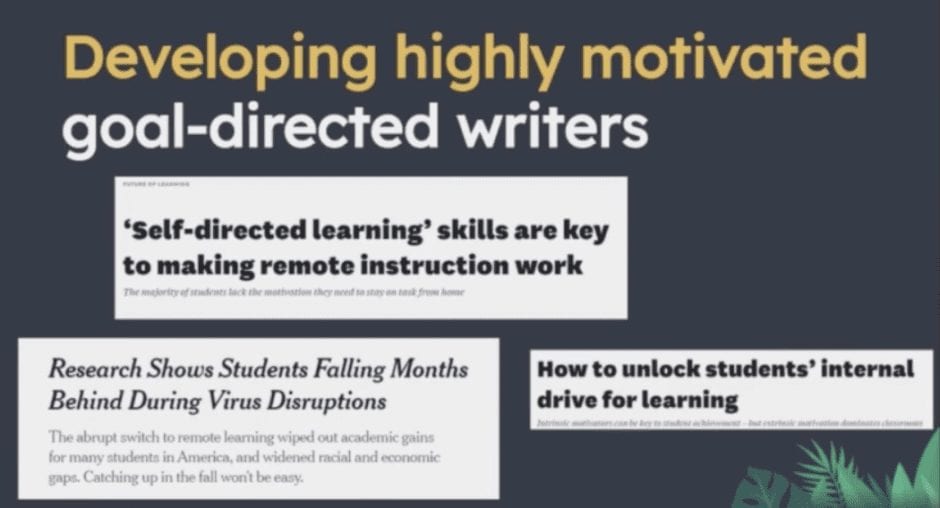Strengthening Schools’ Writing Instruction Through the Use of Data
By Robert Low
Writing is often difficult for educators to teach, challenging for students to do, and hard for administrators to monitor and evaluate. Yet writing well has become an increasingly important 21st century skill due to online college and job applications, as well as the reliance on email and collaborative documents in many 21st century careers.
Ways to compile and use data to guide writing instruction were explained during an edWebinar sponsored by Texthelp, that featured Joni Degner and Mark Schwartz, a Director and a Product Evangelist for Texthelp. Their software can now automate and accelerate many aspects of the writing-evaluation process, though each teacher’s grading and feedback also remain crucial parts of the process.
Degner emphasized that data about writing should not just be used to inform teachers’ interactions with students, it should also play an important role in the ongoing professional learning and evaluation of instruction across grades and schools.
Compiling and Using Data About Writing
As with other forms of data, the goals with writing data are to identify and amplify what is working well, and improve areas of weakness. These goals can be especially challenging to achieve with writing, however, because much of the evaluation that takes place has traditionally been subjective and key aspects of writing can be difficult to quantify.
Schwartz identified three components of writing that can be analyzed objectively and have proven to be good indicators of writing quality. They are correct word sequences (minus incorrect ones), vocabulary maturity in relation to age, and vocabulary diversity. These three metrics can show how well an individual student is writing in relation to other students, and monitoring over time will reveal the progress the student is making in each of the three areas.
Spelling, punctuation, and grammar errors can also be quantified and used as a basis for follow-up instruction. Sentence structure and the use of writing conventions are also factors that should be considered, and in the upper grades the organization of paragraphs and depth of content knowledge come into play as well, but may rely more heavily on subjective teacher evaluations.
Through the compilation and use of all these types of data, educators can provide more personalized instruction, and students can receive positive reinforcement by seeing their progress over time. Administrators can identify best instructional practices and have them shared across classes and grades, or there can be additional professional development and curricular resources where needed.
Informing the Instruction of Writing
Focusing further on writing assessment, Degner emphasized the importance of having rubrics for different types of writing, and having the rubrics related to district writing benchmarks. Along with standardized assessment data, the results of the different types of writing evaluation should be available in ways that provide clarity about the performance of each student, class, and grade, and the effectiveness of the instruction that each is receiving.
The information can then be used to increase success through effective conversations among teachers and administrators, who can identify best practices and analyze the effectiveness of interventions. This can become a cyclical process that continues to improve schoolwide writing instruction year after year, while also increasing student success.
This sort of process and information can also be especially helpful during case conferences for students who have Individualized Education Plans (IEPs). Rather than a vague and subjective conversation, educators can share data about key aspects of the writing process, while also looking at different student assignments and how they were evaluated. In this way, all the participants can have a consistent and evidence-based way to monitor a student’s progress and discuss ways to further individualize the student’s writing instruction.
Through the use of writing data in these ways, schools can develop better writers who have the literacy and communication skills needed to succeed in college and in 21st century careers.
This edWeb broadcast was sponsored by Texthelp.
This article was modified and published by eSchool News.
About the Presenters
Working shoulder to shoulder with learners and educators, Joni Degner is a recognized international expert on the implementation of UDL for schools, districts and institutions of opportunity. A member of the CAST Professional Learning Cadre and now full-time Texthelper, Joni is passionate about Universal Design for Learning, for instructional designers, teachers and leadership. Having previously worked as a UDL facilitator for Bartholomew Consolidated School Corporation, Joni brings a wealth of experience and expertise to the session.
Mark Schwartz taught a range of social studies and ELA classes for over 15 years at both the middle and high school levels, in both urban and suburban districts in Massachusetts, before joining Texthelp as the product evangelist for WriQ, Texthelp’s online assessment tool. Mark has a passion for making teachers’ jobs a little easier while also improving the writing skills of students at all ages and skill levels. He strives to balance the data analysis of WriQ’s writing metrics with the understanding that successful teaching is an artful mix of science, patience, caring, communicating, and collaboration.
Join the Community
ELA Today is a free professional learning community on edWeb.net that provides educators and curriculum leaders with a place to collaborate on best practices for teaching English Language Arts in K12 today.
Hello, we’re Texthelp… We believe that literacy is every student’s passport to academic, social, and professional success. It’s our genuine desire to help students understand, learn, and express themselves. We create smart, user-friendly literacy and learning solutions that provide the support each student needs through reading, writing, STEM, and research. Texthelp software continues to be used daily by millions of students and educators throughout schools, colleges, and universities worldwide.
Robert Low has more than 30 years of educational publishing experience, ranging from editing and product management to online advertising and content development. He also works with edWeb.net to write articles on their professional learning edWebinars.





Comments are closed.